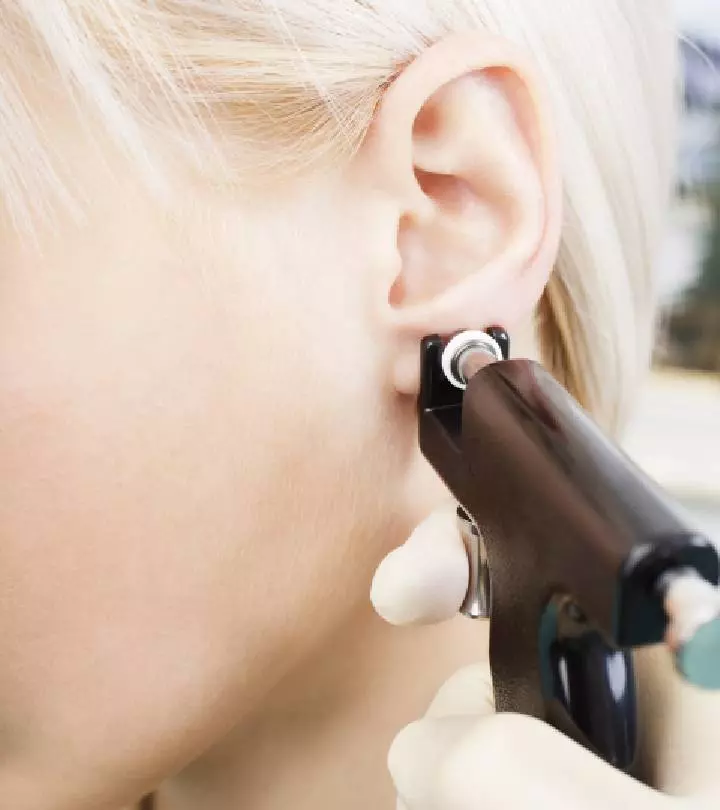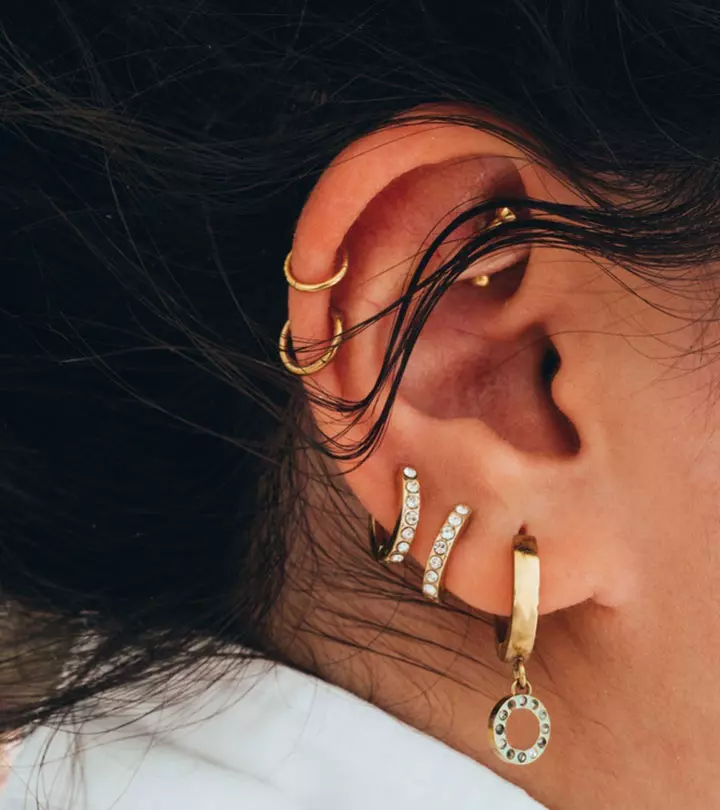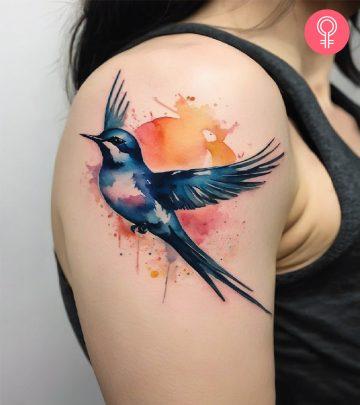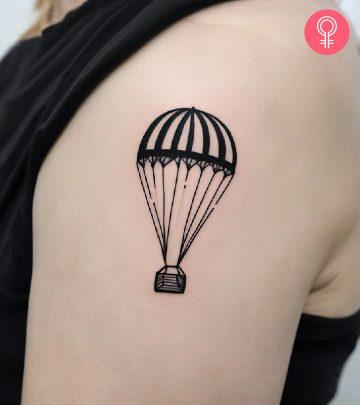Tongue Piercing Healing Stages: Dos, Don’ts, And Aftercare
Explore the potential risks, and treatment involved with a tongue piercing’s healing.

Image: Midjourney/ StyleCraze Design Team
Getting your tongue pierced is an exciting experience, especially for beginners. It’s a fun way to add a touch of glam to your face and you also get to experiment with different jewelry styles and placements. However, before you go ahead, it is crucial to learn about tongue piercing healing and the aftercare process. It’s because simple everyday tasks like eating, drinking, and speaking can complicate the stages of healing. Also, the presence of bacteria in your mouth poses a continuous risk of infection to your unhealed piercing. But don’t worry! In this article, we will discuss all the stages of tongue piercing healing and provide you with tips to avoid any complications. So, keep reading!

In This Article
Tongue Piercing Healing Process

The first few days after tongue piercing are highly crucial. You need to carefully follow all the aftercare instructions given to you by your piercer.
Tongue piercings typically heal in 4-6 weeks (1) but may take longer depending on the location and number of piercings. If the placement is correct and there are no signs of infection, there is no need to worry. However, you still need to stick to basic care practices like cleaning and disinfecting and avoid harmful habits.
The information below will help you navigate through your healing journey, describing the common signs and symptoms that you can expect.
Days 1-2
What To Expect:
- Swelling.
- Bleeding.
- Difficulty in eating and talking.
Why This Happens:
The initial swelling and occasional bleeding in the first two days after a tongue piercing are natural responses to the piercing trauma. The tongue, being highly vascular, has abundant blood vessels. Piercing disrupts these vessels, causing bleeding and inflammation—a part of the body’s natural healing process. Talking and eating may be challenging as the tongue adapts to the new piercing, causing temporary discomfort.
Days 3-5
What To Expect:
- Decrease in swelling and bleeding.
- Sensitivity in tongue.
- White or yellowish fluid.
Why This Happens:
Days 3-5 bring a positive turn in your tongue piercing healing. Swelling and bleeding will decrease, marking the start of healing. Though your tongue may hurt a bit, it is a normal part of the adjustment. You might notice white or yellowish pus oozing from your tongue piercing that may dry up to form the crust, which is nothing to worry about. It is the lymph, a clear liquid that carries white blood cells, helping the body fight infections.
Days 6-10
What To Expect:
- Swelling continues to decrease.
- The initial discomfort should lessen.
- Saliva production may increase.
Why This Happens:
The ongoing decrease in swelling indicates the healing process is going well. The lessening of initial discomfort is a positive sign of your body adapting to the piercing. The increased saliva production is your body’s natural response that helps cleanse and protect the healing site, contributing to a healthier environment for recovery.
 Did you know?
Did you know?Days 10-40
What To Expect:
- Swelling almost gone.
- Thicker, whitish discharge.
- Tongue feeling normal again.
Why This Happens:
During this stage, your tongue will heal significantly, with an almost complete disappearance of swelling, signifying the advanced stages of healing. The thicker, whitish discharge is a normal part of the healing process, indicating the formation of a protective layer around the piercing. The tissues around the piercing will begin to settle and repair the wound, making it feel more comfortable to move your tongue.
Days 41-56
What To Expect:
- The piercing should feel fully healed.
- Any remaining discomfort should be minimal.
- You can resume normal activities.
Why This Happens:
All the pain and discomfort should be gone by this stage. Any remaining discomfort is expected to be minimal as the healing process concludes, allowing you to comfortably resume your normal activities.
You may experience a difference in duration or a few more symptoms than what is stated above, which is perfectly normal. However, if you experience extreme pain or discomfort, foul green discharge, or bleeding even after six weeks, immediately consult your piercer or your healthcare advisor, as this could be a sign of infection or rejection.
Chelsea, a blogger, shared her personal experience with getting multiple piercings on her body. She summed up her eating experience with tongue piercing and wrote, “Liquids are the best friend to you for the first few days too, because, as I found out the hard way, pizza on the day of getting your tongue pierced is impossible (i).”
If you abide by a few dos and don’ts, you can possibly avoid such complications. Read on to ensure safe tongue piercing healing.
Key Takeaways
- Tongue piercings generally take 4-6 weeks to heal.
- You can expect initial swelling and bleeding on days 1-2, symptom reduction on days 3-5, advanced healing on days 10-40, and full healing on days 41-56.
- Follow the piercer’s instructions, maintain oral hygiene, avoid playing with the piercing, and be cautious with your diet choices.
- Infection, allergies, dental damage, migration; seek medical attention for persistent issues.
Dos And Don’ts During The Healing Process
Here are a few things that you need to do and avoid to heal your tongue piercing faster.
Dos
- Drink plenty of water to support overall well-being and promote a healthy healing environment.
- Opt for softer foods during the initial healing period to minimize irritation and discomfort.
- Adhere to the aftercare guidelines provided by your piercer diligently to promote proper healing.
- Brush your teeth and rinse your mouth regularly to prevent infection and maintain overall oral health.
- Rinse your mouth with a non-alcoholic, saline-based mouthwash to keep the piercing clean without irritating.
- Handle your tongue with care, especially while cleaning or checking the piercing. Avoid unnecessary movement.
Don’ts
- Resist the temptation to touch or play with the piercing, as it can introduce bacteria and hinder the healing process.
- Refrain from consuming acidic foods or spicy foods that may irritate the piercing site.
- Avoid consuming crunchy foods or hard foods that could potentially damage the piercing or cause discomfort. Consume soft foods that won’t need much chewing.
- Limit or avoid alcohol, and tobacco during the healing time, as they can slow down the healing process and increase the risk of complications.
- Steer clear of oral contact during intimate moments to prevent unnecessary irritation to the healing piercing.
- Resist the urge to remove the jewelry before the recommended healing period, as premature removal can disrupt the healing process.
- Avoid swimming in pools or hot tubs during the initial healing period to minimize exposure to bacteria, thus reducing chances of infection.
These tips will help you make your tongue piercing heal faster. But the aftercare is not supposed to stop once your piercing is healed. It is important to continue caring for your tongue piercing to avoid any complications. Read the following section to learn how.
Tips For Long-Term Care

Apart from continuing to maintain good oral hygiene and staying hydrated, there are a few other things you have to be careful of. They are as follows:
- Avoid habits like playing with the piercing or biting on jewelry to prevent irritation.
- Keep an eye out for any unusual symptoms, such as excessive redness, swelling, or unusual discharge, and seek professional advice if needed.
- Consider downsizing jewelry if recommended by a professional piercer for enhanced comfort during long-term wear.
Regular check-ups with a professional piercer will ensure that your tongue piercing heals properly. Your piercer can check for any signs of infection, irritation, or other complications that may not be visible to you. They can also make sure the jewelry is fitting correctly and make adjustments if needed.
 Trivia
TriviaRemember that individual healing experiences may vary, which can also change these aftercare tips from person to person. If the problem aggravates or leads to infection, you may opt for home remedies and clinical treatment. Scroll down to learn about them.
Treatment And Home Remedies For Tongue Piercing Healing
Common practices of oral piercing aftercare often involve the use of warm saline rinses, non-alcoholic mouthwashes, and, if necessary, topical or oral antibiotics, as follows:
Home Remedies
Healing after a tongue piercing is often the quickest and safest way to prevent the infection from spreading. Here are some general guidelines for treatment and home remedies:
- Saltwater Rinse
Mix a solution of warm water and non-iodized sea salt (about 1/4 teaspoon of salt in 8 ounces of water). Gently rinse your mouth with this solution after meals and before bed.
- Clove Mixture
Dilute 1-2 drops of clove oil in warm water, gargle or rinse, and repeat as needed, but consult a professional if problems persist. Clove oil contains strong antifungal and antibacterial properties and may act as a potent remedy for treating oral infections (3).
Treatment
- Antibiotics
Oral antibiotics like cephalexin or clindamycin could be prescribed to address infections caused by bacteria (4).
Over-the-counter antibiotics from a drug store such as trimethoprim/sulfamethoxazole may be recommended for better coverage on the site of infection (4).
For oral piercing infections, it is important to follow the guidance of a reputable piercer and consult with healthcare professionals. While these treatments are effective, avoiding them can adversely affect your oral health, as discussed below. Scroll down.
Potential Risks Of Tongue Piercings

Despite all the treatments, you might face certain hurdles during the healing process. Here are some of the potential risks of tongue piercings:
- Infection
The piercing site is susceptible to bacterial infections. Redness, swelling, and discharge may indicate an infection, and prompt attention is crucial.
- Speech Impairment
Initial tongue swelling may affect speech temporarily (5). Persistent impairment may indicate a problem that needs attention.
- Excessive Saliva Production
During the healing process, you might face complications such as sialorrhea or excessive production of saliva (5).
- Allergic Reactions
Reacting to the metal in the jewelry is possible in tongue piercing. Choose hypoallergenic materials and consult your piercer if you notice signs of an allergic response.
- Migration Or Rejection
The body may perceive the jewelry as a foreign object, leading to migration (shifting) or rejection (forcing the jewelry out).
- Damage To Teeth
Tongue piercings can damage your teeth over time by chipping or cracking them, especially if you accidentally bite down on the jewelry. Constant contact with the piercing can also wear down tooth enamel.
- Nerve Damage
In rare cases, nerve damage may occur, leading to prolonged numbness or altered sensation in the tongue (6).
- Aspiration Risk
Swallowing the jewelry, beads, or other accessories poses a risk during healing. Be cautious to avoid such incidents by checking that your jewelry is firmly attached and avoiding fiddling with it (5).
It is crucial to be aware of these potential risks, closely follow aftercare guidelines, and promptly address any concerns by consulting with your piercer. Read the next section to learn when you need to visit your healthcare professional.
When To See A Doctor

If you notice ongoing redness, swelling, or discharge around your tongue piercing, or if you have severe swelling that makes eating or talking difficult, it’s important to see a doctor. Any signs of allergy, like itching or rash, should be checked too. If the jewelry moves a lot or if you feel ongoing pain or strange sensations, it is a good idea to seek medical advice. Also, if you accidentally damage your teeth or have trouble breathing or swallowing because of the piercing, it is time to see a doctor. And don’t forget, if you ever worry that you might swallow the jewelry, get medical help right away.
The process of healing a tongue piercing demands careful attention and adherence to aftercare instructions. Initial discomfort, swelling, and bleeding are natural, but with proper care, these symptoms gradually diminish. Following dos and don’ts, practicing long-term care, and understanding potential risks contribute to a successful healing journey. Knowing when to seek professional advice ensures a prompt response to any complications. Embracing a balanced approach, coupled with awareness, fosters a comfortable and healthy tongue piercing experience.
Frequently Asked Questions
What does a healing tongue piercing look like?
A healing tongue piercing typically appears slightly swollen, may have a whitish discharge (lymph), and the surrounding area might be mildly red. This is normal during the initial stages of healing.
How do you sleep with a new tongue piercing?
Sleep on your back to minimize pressure on the healing piercing. Avoid sleeping on your stomach or with your face pressed against the pillow to prevent irritation.
Should my tongue piercing still hurt after 3 days?
Some discomfort is normal, but severe pain after three days may indicate a problem. Consult your piercer or a healthcare professional for advice.
How do I know if my tongue piercing is healing the right way?
Signs of proper healing include decreasing swelling and minimal pain. But if you see unusual symptoms like excessive redness or green discharge, it may be a sign of an infected tongue piercing. Regular check-ups with your piercer can confirm proper healing.
The healing process of tongue piercing can be a bit scary for first-timers who don’t know what to expect. Learn what to expect during the first week of healing. Watch this video to get a detailed documention.
Personal Experience: Source
StyleCraze's articles are interwoven with authentic personal narratives that provide depth and resonance to our content. Below are the sources of the personal accounts referenced in this article.
(i) My piercing experience,https://chelseaswriting.wordpress.com/2012/07/11/my-piercing-experience/
References
Articles on StyleCraze are backed by verified information from peer-reviewed and academic research papers, reputed organizations, research institutions, and medical associations to ensure accuracy and relevance. Read our editorial policy to learn more.
- Oral Piercing: A Pretty Risk—A Scoping Review of Local and Systemic Complications of This Current Widespread Fashion
https://www.ncbi.nlm.nih.gov/pmc/articles/PMC10177791/ - Saliva and wound healing
https://pubmed.ncbi.nlm.nih.gov/23878824/ - Microbicide activity of clove essential oil (Eugenia caryophyllata)
https://www.ncbi.nlm.nih.gov/pmc/articles/PMC3769004/ - Body Piercing Infections
https://www.ncbi.nlm.nih.gov/books/NBK537336/ - Oral and Perioral Piercing Complications
https://www.ncbi.nlm.nih.gov/pmc/articles/PMC2606659/ - Oral Piercing and Oral Diseases: A Short Time Retrospective Study
https://www.ncbi.nlm.nih.gov/pmc/articles/PMC3204433/
Read full bio of Anastasiia Gatsko
Read full bio of Aparna Harry
Read full bio of Asmita De
Read full bio of Gracia Odile



























Community Experiences
Join the conversation and become a part of our empowering community! Share your stories, experiences, and insights to connect with other beauty, lifestyle, and health enthusiasts.